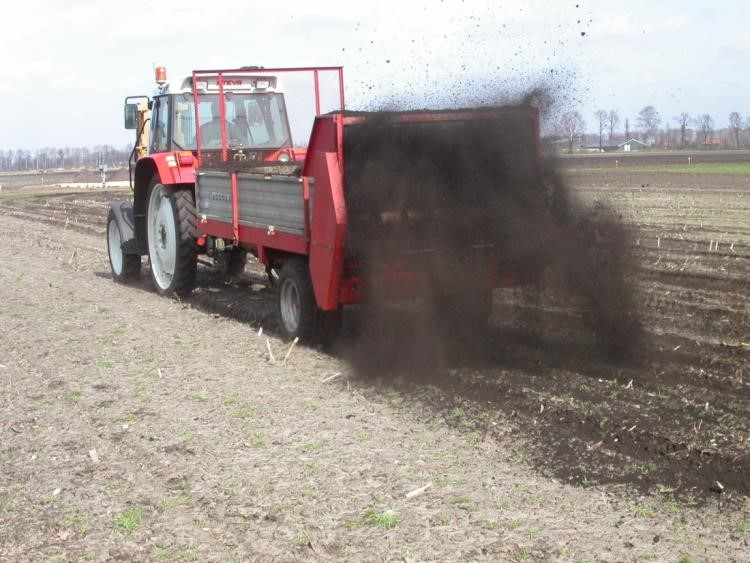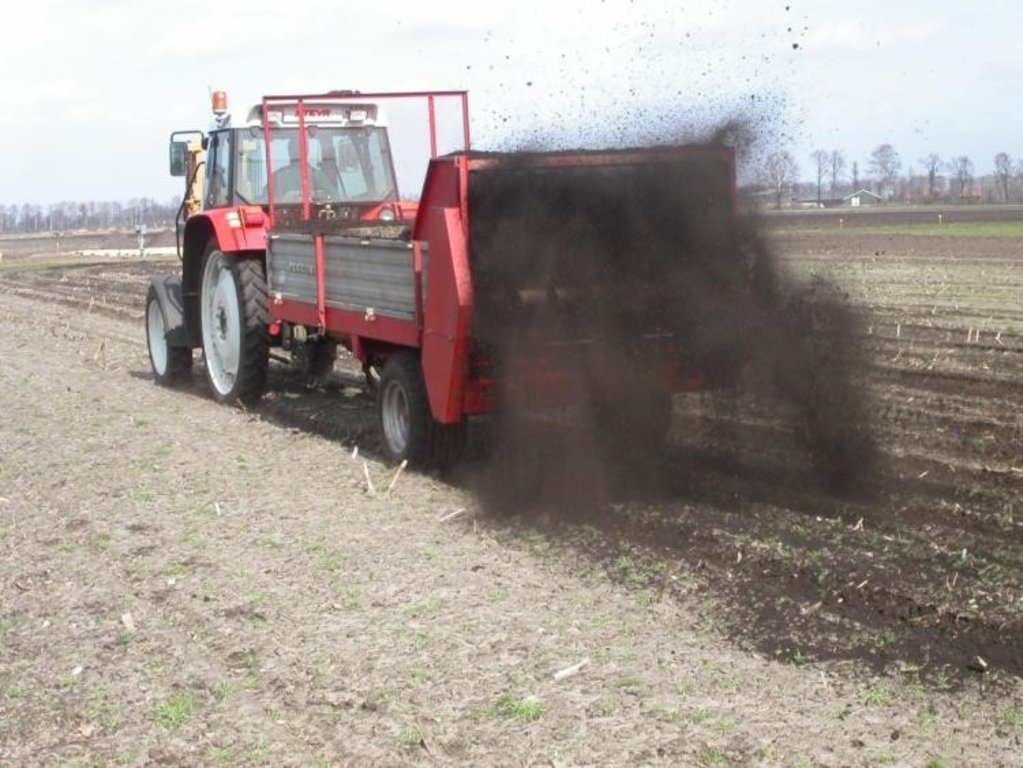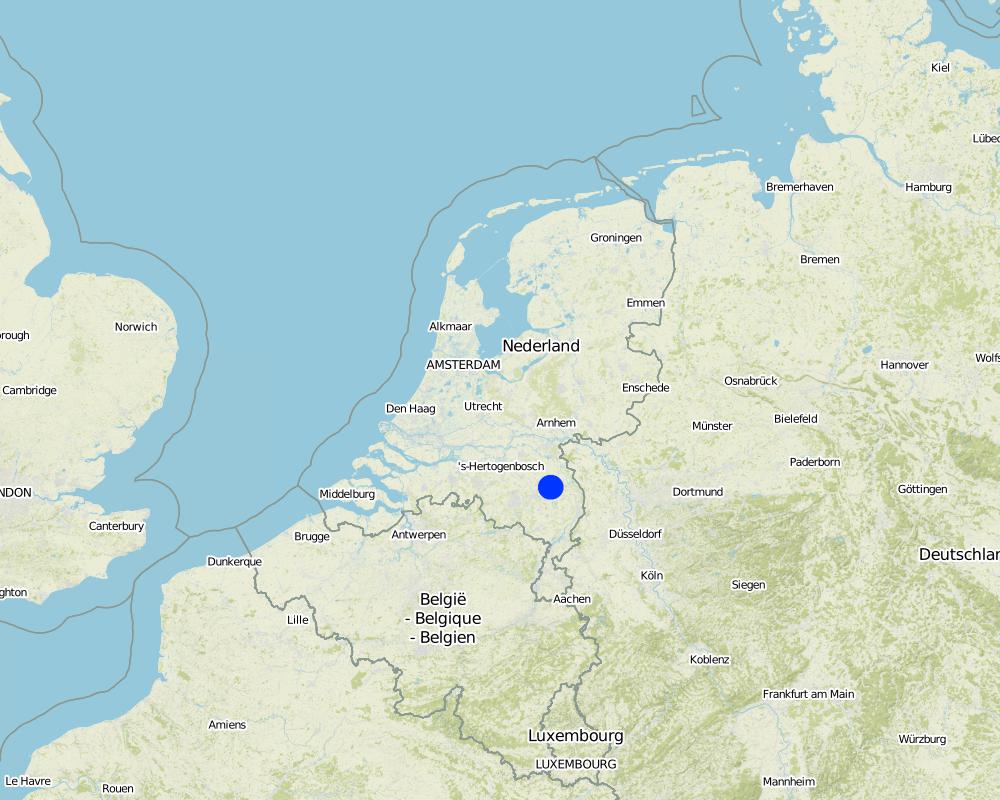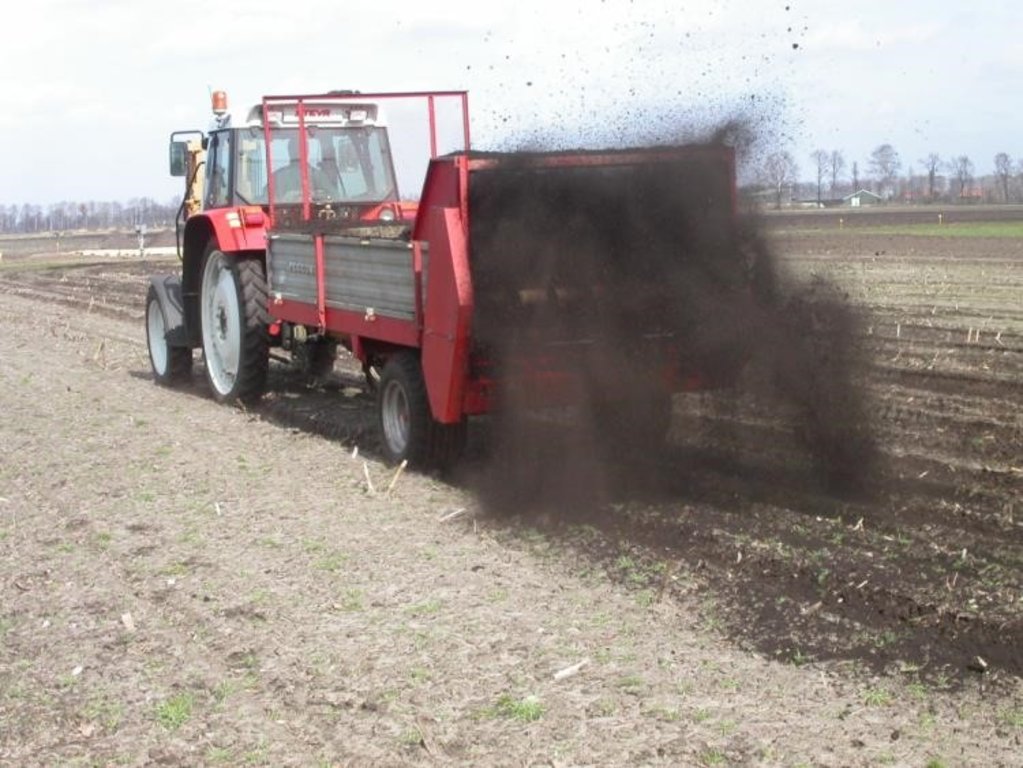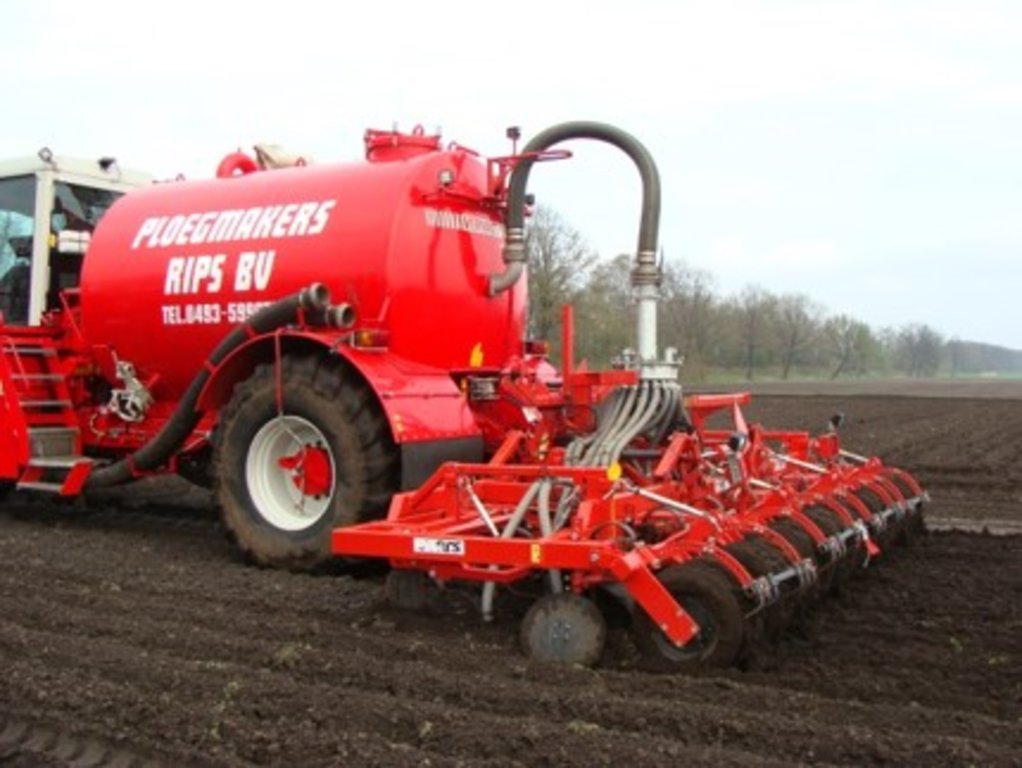Increased organic matter input by using organic fertilizers (slurry and manure) instead of mineral fertilizers [荷兰]
- 创建:
- 更新:
- 编制者: wijnand sukkel
- 编辑者: Marie Wesselink
- 审查者: Ursula Gaemperli, Gudrun Schwilch, Alexandra Gavilano
Verhoogde organische stof aanvoer door gebruik van organische bemesting in plaats van minerale bemesting
technologies_2965 - 荷兰
查看章节
全部展开 全部收起1. 一般信息
1.2 参与该技术评估和文件编制的资源人员和机构的联系方式
有助于对技术进行记录/评估的项目名称(如相关)
Interactive Soil Quality assessment in Europe and China for Agricultural productivity and Environmental Resilience (EU-iSQAPER)有助于对技术进行记录/评估的机构名称(如相关)
Stichting Dienst Landbouwkundig Onderzoek, Wageningen University & Research Centre (DLO) - 荷兰1.3 关于使用通过WOCAT记录的数据的条件
编制者和关键资源人员接受有关使用通过WOCAT记录数据的条件。:
是
1.4 所述技术的可持续性声明
这里所描述的技术在土地退化方面是否存在问题,导致无法被认为是一种可持续的土地管理技术?:
否
2. SLM技术的说明
2.1 技术简介
技术定义:
Mineral ferilizers are (partly) replaced by organic fertilizers in order to have a higher organic matter input
2.2 技术的详细说明
说明:
The technology is applied in arable/vegetable production systems in de Peel. De Peel is a sandy soil rural region in the southeast of the Netherlands. The technology is not limited by soil type or crop production system. An important requisite is the availability of manure.
The technology is applied on conventional farms. Mineral fertilizers are (partly) replaced by organic fertilizers. The yearly crop fertilization is mainly based on slurry which is in abundance available in the region. The amount of organic fertilizers is restricted by national and regional legislation related to the total input of Nitrogen and Phosphorus. Occasionally additional solid manure and/or compost is put in (autumn). Extra organic matter input by manure is sometimes combined with emphasis on the use of cover crops which gives an additional input of organic matter as well.
Main purposes of the technology are to improve soil quality in general, reduce wind erosion, reduce nitrate leaching, increase soil biodiversity and make the soil more resilient to stress factors like drought or excessive rainfall.
Major activities are reduction of mineral fertilisers and the increase of organic fertilizers. This is accompanied by the additional use of cover crops whenever possible.
The impacts are so far an increase of soil organic matter, an increase of soil biodiversity, higher yields and a higher soil resilience.
Landusers like the technology because of the better soil quality, increase of yields, lower input costs (farmers are paid to use manure, since there is an excess in the region ). farmers dislike the technology because of the risks of compaction because of the heavy loads of slurry. Another negative effect is the less predictable nutriënt availability in the soil of organic fertilisers. Also the costs and of additional sowing of cover crops is considered a negative aspect. Having the correct machinery is not an issue, since there are a lot of cooperations with contractors who can do the application for you.
2.3 技术照片
2.5 已应用该技术的、本评估所涵盖的国家/地区/地点
国家:
荷兰
区域/州/省:
De Peel
有关地点的进一步说明:
Near the village Vredepeel
具体说明该技术的分布:
- 均匀地分布在一个区域
注释:
I think the area size depends on how big you estimate the study site area, but most of the farmers use (at least partly) organic manure. This may be up around 80% of the farmers.
Map
×2.6 实施日期
注明实施年份:
1998
2.7 技术介绍
详细说明该技术是如何引入的:
- 在实验/研究期间
注释(项目类型等):
Research has shown that organic matter input is of vital importance if you want to maintain your soil quality. Farmers know this, all farmers in the region use at least partly organic manure.
3. SLM技术的分类
3.1 该技术的主要目的
- 改良生产
- 减少、预防、恢复土地退化
- 保持/提高生物多样性
- 适应气候变化/极端天气及其影响
- 创造有益的经济影响
3.2 应用该技术的当前土地利用类型

农田
- 一年一作
年作 - 具体指明作物:
- 谷类 - 大麦
- 谷物类 - 玉米
- 豆科牧草和豆类 - 豌豆
- 根/块茎作物 - 土豆
- 根/块茎作物 - 甜菜
- 蔬菜 - 根茎类蔬菜(胡萝卜、洋葱、甜菜等)
每年的生长季节数:
- 1
注释:
Main crops (cash and food crops): sugarbeet, processing peas, leek, carrots, spring barley, silage maize, potatoes
3.4 供水
该技术所应用土地的供水:
- 混合雨水灌溉
3.5 该技术所属的SLM组
- 土壤肥力综合管理
3.6 包含该技术的可持续土地管理措施

农艺措施
- A1:植被和土壤覆盖层
- A2:有机质/土壤肥力
3.7 该技术强调的主要土地退化类型

土壤风蚀
- Et:表土流失

化学性土壤退化
- Cn:肥力下降和有机质含量下降(非侵蚀所致)

物理性土壤退化
- Pc:压实

生物性退化
- Bl:土壤寿命损失

水质恶化
- Hq:地下水水质下降
3.8 防止、减少或恢复土地退化
具体数量名该技术与土地退化有关的目标:
- 防止土地退化
4. 技术规范、实施活动、投入和成本
4.1 该技术的技术图纸
技术规范(与技术图纸相关):
Before planting/sowing organic manure is added to the soil, either by spreading it on top of the soil (photo 1) or injecting it in the soil (photo 2)
4.2 有关投入和成本计算的一般信息
具体说明成本和投入是如何计算的:
- 每个技术区域
注明尺寸和面积单位:
50 ha
其它/国家货币(具体说明):
Euro
如相关,注明美元与当地货币的汇率(例如1美元=79.9巴西雷亚尔):1美元=:
0.87
注明雇用劳工的每日平均工资成本:
160
4.4 技术建立所需要的费用和投入
注释:
There are no costs for establishment. Possibly in some case equipment to spread slurry, however this is mostly done by contract work.
4.5 维护/经常性活动
| 活动 | 时间/频率 | |
|---|---|---|
| 1. | fertilisation with slurry | once a year in early spring |
| 2. | sowing of cover crops | late summer/ early autumn |
| 3. | incorporating cover crops | late winter/early spring |
4.6 维护/经常性活动所需要的费用和投入(每年)
| 对投入进行具体说明 | 单位 | 数量 | 单位成本 | 每项投入的总成本 | 土地使用者承担的成本% | |
|---|---|---|---|---|---|---|
| 植物材料 | seed costs and sowing cover crops | ha | 50.0 | 100.0 | 5000.0 | 100.0 |
| 肥料和杀菌剂 | compost application | m3 | 250.0 | 15.0 | 3750.0 | 100.0 |
| 肥料和杀菌剂 | solid manure application | m3 | 250.0 | 10.0 | 2500.0 | 100.0 |
| 肥料和杀菌剂 | pig slurry application | m3 | 1000.0 | -10.0 | -10000.0 | 100.0 |
| 技术维护所需总成本 | 1250.0 | |||||
| 技术维护总成本,美元 | 1436.78 | |||||
注释:
Not calculated is the profit for the reduction of mineral inputs. For pig slurry there are negative costs because the pig farmer has to pay the arable farmer to get rid of his slurry.
Costs for labour and machinery to apply the manure and for sowing are included in the application numbers.
4.7 影响成本的最重要因素
描述影响成本的最决定性因素:
price of compost and solid manure, negative price of pig slurry, costs for seed and sowing cover crops
5. 自然和人文环境
5.1 气候
年降雨量
- < 250毫米
- 251-500毫米
- 501-750毫米
- 751-1,000毫米
- 1,001-1,500毫米
- 1,501-2,000毫米
- 2,001-3,000毫米
- 3,001-4,000毫米
- > 4,000毫米
指定年平均降雨量(若已知),单位为mm:
850.00
注明所考虑的参考气象站名称:
Volkel the Netherlands
农业气候带
- 半湿润
5.2 地形
平均坡度:
- 水平(0-2%)
- 缓降(3-5%)
- 平缓(6-10%)
- 滚坡(11-15%)
- 崎岖(16-30%)
- 陡峭(31-60%)
- 非常陡峭(>60%)
地形:
- 高原/平原
- 山脊
- 山坡
- 山地斜坡
- 麓坡
- 谷底
垂直分布带:
- 0-100 m a.s.l.
- 101-500 m a.s.l.
- 501-1,000 m a.s.l.
- 1,001-1,500 m a.s.l.
- 1,501-2,000 m a.s.l.
- 2,001-2,500 m a.s.l.
- 2,501-3,000 m a.s.l.
- 3,001-4,000 m a.s.l.
- > 4,000 m a.s.l.
说明该技术是否专门应用于:
- 不相关
5.3 土壤
平均土层深度:
- 非常浅(0-20厘米)
- 浅(21-50厘米)
- 中等深度(51-80厘米)
- 深(81-120厘米)
- 非常深(> 120厘米)
土壤质地(表土):
- 粗粒/轻(砂质)
土壤质地(地表以下> 20厘米):
- 粗粒/轻(砂质)
表土有机质:
- 高(>3%)
5.4 水资源可用性和质量
地下水位表:
< 5米
地表水的可用性:
好
水质(未处理):
仅供农业使用(灌溉)
水的盐度有问题吗?:
否
该区域正在发生洪水吗?:
否
5.5 生物多样性
物种多样性:
- 中等
栖息地多样性:
- 中等
5.6 应用该技术的土地使用者的特征
定栖或游牧:
- 定栖的
生产系统的市场定位:
- 商业/市场
非农收入:
- 低于全部收入的10%
相对财富水平:
- 丰富
个人或集体:
- 个人/家庭
机械化水平:
- 机械化/电动
性别:
- 男人
土地使用者的年龄:
- 中年人
5.7 应用该技术的土地使用者使用的平均土地面积
- < 0.5 公顷
- 0.5-1 公顷
- 1-2 公顷
- 2-5公顷
- 5-15公顷
- 15-50公顷
- 50-100公顷
- 100-500公顷
- 500-1,000公顷
- 1,000-10,000公顷
- > 10,000公顷
这被认为是小规模、中规模还是大规模的(参照当地实际情况)?:
- 中等规模的
5.8 土地所有权、土地使用权和水使用权
土地所有权:
- 个人,有命名
土地使用权:
- 个人
用水权:
- 社区(有组织)
5.9 进入服务和基础设施的通道
健康:
- 贫瘠
- 适度的
- 好
教育:
- 贫瘠
- 适度的
- 好
技术援助:
- 贫瘠
- 适度的
- 好
就业(例如非农):
- 贫瘠
- 适度的
- 好
市场:
- 贫瘠
- 适度的
- 好
能源:
- 贫瘠
- 适度的
- 好
道路和交通:
- 贫瘠
- 适度的
- 好
饮用水和卫生设施:
- 贫瘠
- 适度的
- 好
金融服务:
- 贫瘠
- 适度的
- 好
6. 影响和结论性说明
6.1 该技术的现场影响
社会经济效应
生产
作物生产
注释/具体说明:
Compared with the control (same crop, same management) we found higher yields
饲料生产
注释/具体说明:
Compared with the control (same crop, same management) we found higher yields
收入和成本
农业投入费用
注释/具体说明:
Manure is more expensive than mineral fertiliser, but because of the excess of manure in the region the prices are negative and this is compensated
农业收入
注释/具体说明:
The costs do not rise, but the yield does, so also a higher income.
生态影响
水循环/径流
水质
注释/具体说明:
Organic matter is capable of binding nutrients, so less nutrients will leach to the water.
土壤
土壤覆盖层
注释/具体说明:
More green manure crops are used, so the soil is covered more time in the year.
土壤压实
注释/具体说明:
The amounts of organic manure have a heavy weight, and are applied to the soil with heavy machinery which would not be necessary if you only use mineral fertiliser.
土壤有机物/地下C
注释/具体说明:
More organic matter is applied, so soil organic matter levels will increase.
生物多样性:植被、动物
有益物种
注释/具体说明:
More organic matter and more green manure crops create better living circumstances for these species.
6.2 该技术的场外影响已经显现
地下水/河流污染
6.3 技术对渐变气候以及与气候相关的极端情况/灾害的暴露和敏感性(土地使用者认为的极端情况/灾害)
气候有关的极端情况(灾害)
气象灾害
| 该技术是如何应对的? | |
|---|---|
| 局地暴雨 | 好 |
气候灾害
| 该技术是如何应对的? | |
|---|---|
| 干旱 | 好 |
6.4 成本效益分析
技术收益与技术建立成本相比如何(从土地使用者的角度看)?
短期回报:
中性/平衡
长期回报:
稍微积极
技术收益与技术维护成本/经常性成本相比如何(从土地使用者的角度看)?
短期回报:
中性/平衡
长期回报:
稍微积极
6.5 技术采用
- 1-10%
在所有采用这项技术的人当中,有多少人是自发的,即未获得任何物质奖励/付款?:
- 91-100%
6.6 适应
最近是否对该技术进行了修改以适应不断变化的条件?:
否
6.7 该技术的优点/长处/机会
| 土地使用者眼中的长处/优势/机会 |
|---|
| Higher yields |
| better soil quality in general |
| 编制者或其他关键资源人员认为的长处/优势/机会 |
|---|
| more resilient soil |
| more soil life |
6.8 技术的弱点/缺点/风险及其克服方法
| 土地使用者认为的弱点/缺点/风险 | 如何克服它们? |
|---|---|
| it is somewhat more difficult to calculate and make sure you have all the nutrients in correct amounts on your field | take samples from the manure, and get used to the calculations |
| you still have to add mineral fertilizer, because the manure does not have all nutrients in the right amounts | not. |
| 编制者或其他关键资源人员认为的弱点/缺点/风险 | 如何克服它们? |
|---|---|
| risk of soil compaction | Don't bring all the manure for the whole field at once, several smaller portions. |
7. 参考和链接
7.1 信息的方法/来源
- 实地考察、实地调查
- 与SLM专业人员/专家的访谈
(现场)数据是什么时候汇编的?:
19/07/2017
链接和模块
全部展开 全部收起链接
无链接
模块
无模块


